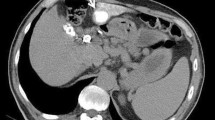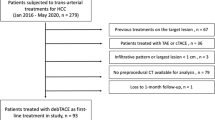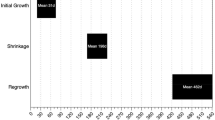Abstract
Purpose
To determine if the pattern of retained contrast on immediate postprocedure computed tomography (CT) after particle embolization of hepatic tumors predicts modified Response Evaluation Criteria in Solid Tumors (mRECIST) response.
Materials and Methods
This study was approved by the Institutional Review Board with a waiver of authorization. One hundred four liver tumors were embolized with spherical embolic agents (Embospheres, Bead Block, LC Bead) and polyvinyl alcohol. Noncontrast CT was performed immediately after embolization to assess contrast retention in the targeted tumors, and treatment response was assessed by mRECIST criteria on follow-up CT (average time 9.0 ± 7.7 weeks after embolization). Tumor contrast retention (TCR) was determined based on change in Hounsfield units (HUs) of the index tumors between the preprocedure and immediate postprocedure scans; vascular contrast retention (VCR) was rated; and defects in contrast retention (DCR) were also documented. The morphology of residual enhancing tumor on follow-up CT was described as partial, circumferential, or total. Association between TCR variables and tumor response were assessed using multivariate logistic regression.
Results
Of 104 hepatic tumors, 51 (49 %) tumors had complete response (CR) by mRECIST criteria; 23 (22.1 %) had partial response (PR); 21 (20.2 %) had stable disease (SD); and 9 (8.7 %) had progressive disease (PD). By multivariate analysis, TCR, VCR, and tumor size are independent predictors of CR (p = 0.02, 0.05, and 0.005 respectively). In 75 tumors, DCR was found to be an independent predictor of failure to achieve complete response (p < 0.0001) by imaging criteria.
Conclusion
TCR, VCR, and DCR on immediate posttreatment CT are independent predictors of CR by mRECIST criteria.





Similar content being viewed by others
References
Dhanasekaran R, Kooby DA, Staley CA et al (2010) Comparison of conventional transarterial chemoembolization (TACE) and chemoembolization with doxorubicin drug eluting beads (DEB) for unresectable hepatocelluar carcinoma (HCC). J Surg Oncol 101(6):476–480
Kim JH, Yoon HK, Ko GY et al (2010) Nonresectable combined hepatocellular carcinoma and cholangiocarcinoma: analysis of the response and prognostic factors after transcatheter arterial chemoembolization. Radiology 255(1):270–277
Nazario J, Gupta S (2010) Transarterial liver-directed therapies of neuroendocrine hepatic metastases. Semin Oncol 37(2):118–126
Malagari K, Pomoni M, Spyridopoulos TN et al (2011) Safety profile of sequential transcatheter chemoembolization with DC Bead: results of 237 hepatocellular carcinoma (HCC) patients. Cardiovasc Intervent Radiol 34(4):774–785
Liapi E, Geschwind JF (2010) Chemoembolization for primary and metastatic liver cancer. Cancer J 16(2):156–162
Lencioni R, de Baere T, Burrel M et al (2011) Transcatheter treatment of hepatocellular carcinoma with doxorubicin-loaded DC Bead (DEBDOX): technical recommendations. Cardiovasc Intervent Radiol 35:980–985
Tadavarthy SM, Knight L, Ovitt TW et al (1974) Therapeutic transcatheter arterial embolization. Radiology 112(1):13–16
Allison DJ, Modlin IM, Jenkins WJ (1977) Treatment of carcinoid liver metastases by hepatic-artery embolisation. Lancet 2(8052–8053):1323–1325
Bonomo G, Pedicini V, Monfardini L et al (2010) Bland embolization in patients with unresectable hepatocellular carcinoma using precise, tightly size-calibrated, anti-inflammatory microparticles: first clinical experience and one-year follow-up. Cardiovasc Intervent Radiol 33(3):552–559
Covey AM, Maluccio MA, Schubert J et al (2006) Particle embolization of recurrent hepatocellular carcinoma after hepatectomy. Cancer 106(10):2181–2189
Maluccio MA, Covey AM, Porat LB et al (2008) Transcatheter arterial embolization with only particles for the treatment of unresectable hepatocellular carcinoma. J Vasc Interv Radiol 19(6):862–869
Lewis AL, Adams C, Busby W et al (2006) Comparative in vitro evaluation of microspherical embolisation agents. J Mater Sci Mater Med 17(12):1193–1204
Uchida H, Matsuo N, Nishimine K et al (1993) Transcatheter arterial embolization for hepatoma with lipiodol—Hepatic arterial and segmental use. Semin Intervent Radiol 10(1):19–26
Choi BI, Kim HC, Han JK et al (1992) Therapeutic effect of transcatheter oily chemoembolization therapy for encapsulated nodular hepatocellular carcinoma: cT and pathological findings. Radiology 182(3):709–713
Tognolini A, Louie JD, Hwang GL et al (2010) Utility of C-arm CT in patients with hepatocellular carcinoma undergoing transhepatic arterial chemoembolization. J Vasc Interv Radiol 21(3):339–347
Vogl TJ, Trapp M, Schroeder H et al (2000) Transarterial chemoembolization for hepatocellular carcinoma: volumetric and morphologic CT criteria for assessment of prognosis and therapeutic success—Results from a liver transplantation center. Radiology 214(2):349–357
Takayasu K, Muramatsu Y, Maeda T et al (2001) Targeted transarterial oily chemoembolization for small foci of hepatocellular carcinoma using a unified helical CT and angiography system: analysis of factors affecting local recurrence and survival rates. AJR Am J Roentgenol 176(3):681–688
Lencioni R, Llovet JM (2010) Modified RECIST (mRECIST) assessment for hepatocellular carcinoma. Semin Liver Dis 30(1):52–60
Berber E, Foroutani A, Garland AM et al (2000) Use of CT Hounsfield unit density to identify ablated tumor after laparoscopic radiofrequency ablation of hepatic tumors. Surg Endosc 14(9):799–804
Herber S, Biesterfeld S, Franz U et al (2008) Correlation of multislice CT and histomorphology in HCC following TACE: predictors of outcome. Cardiovasc Intervent Radiol 31(4):768–777
Fujita T, Ito K, Tanabe M et al (2008) Iodized oil accumulation in hypervascular hepatocellular carcinoma after transcatheter arterial chemoembolization: comparison of imaging findings with CT during hepatic arteriography. J Vasc Interv Radiol 19(3):333–341
Kloeckner R, Otto G, Biesterfeld S et al (2010) MDCT versus MRI assessment of tumor response after transarterial chemoembolization for the treatment of hepatocellular carcinoma. Cardiovasc Intervent Radiol 33(3):532–540
Moschouris H, Malagari K, Papadaki MG et al (2010) Contrast-enhanced ultrasonography of hepatocellular carcinoma after chemoembolisation using drug-eluting beads: a pilot study focused on sustained tumor necrosis. Cardiovasc Intervent Radiol 33(5):1022–1027
Sze DY, Razavi MK, So SK et al (2001) Impact of multidetector CT hepatic arteriography on the planning of chemoembolization treatment of hepatocellular carcinoma. AJR Am J Roentgenol 177(6):1339–1345
Iwazawa J, Ohue S, Mitani T et al (2009) Identifying feeding arteries during TACE of hepatic tumors: comparison of C-arm CT and digital subtraction angiography. AJR Am J Roentgenol 192(4):1057–1063
Conflict of interest
Stephen B. Solomon received a research grant from GE Healthcare (Milwaukee, WI).
Author information
Authors and Affiliations
Corresponding author
Rights and permissions
About this article
Cite this article
Wang, X., Erinjeri, J.P., Jia, X. et al. Pattern of Retained Contrast on Immediate Postprocedure Computed tomography (CT) After Particle Embolization of Liver Tumors Predicts Subsequent Treatment Response. Cardiovasc Intervent Radiol 36, 1030–1038 (2013). https://doi.org/10.1007/s00270-012-0506-x
Received:
Accepted:
Published:
Issue Date:
DOI: https://doi.org/10.1007/s00270-012-0506-x




